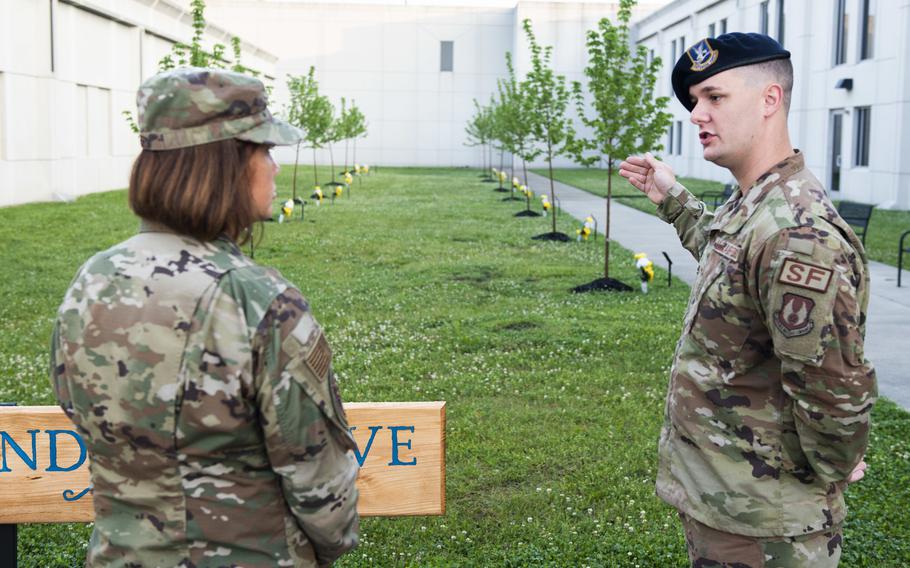
Chief Master Sergeant of the Air Force JoAnne S. Bass is briefed by Senior Airman Mark Debats of the 88th Security Forces Squadron on the unit’s Defenders Grove upon her arrival at the unit June 4, 2021, as part of a multiday tour of Wright-Patterson Air Force Base, Ohio. Defenders Grove, which honors fallen Security Forces Airmen lost since 9/11, was dedicated at WPAFB last October. The tour brought Bass to several units within the 88th Air Base Wing, Air Force Materiel Command, Air Force Life Cycle Management Center and Air Force Research Laboratory. (Wesley Farnsworth/Air Force)
(Tribune News Service) — Air Force and Space Force commanders, as well as U.S. Rep. Mike Turner, R-Dayton, expounded on Ohio’s role in national security intelligence, and the increasing role cybersecurity and space capabilities play in modern warfare, during the Ohio Defense & Aerospace Forum Monday at Wright State University.
That role, it turns out, is a big one. The National Space Intelligence Center, the main intelligence arm of the young U.S. Space Force, and its older and much larger counterpart, the National Air and Space Intelligence Center, process the vast majority of space and cyberspace military intelligence the country has today.
“Roughly about 85% of the space intelligence our nation uses is right here at Wright-Patt,” said Col. Marqus Randall, commander of NSIC. The United States Space Force force delivers scientific and technical intelligence to help national leaders and warfighters act in the realm of space. As the military pivots to digital and extraterrestrial security, both China and Russia have been public about space and cyberspace as warfighting arenas, Russell said, adding that since 2015, China has increased their aerospace capabilities by 380%.
In 2015, China set up the strategic support forces, and that same year, Russia’s aerospace forces both included space, cyberspace, and electronic warfare, as part of their core operation, he said. “They’ve been very explicit. They’ve made it known,” Russell said.
Additionally, the use of artificial intelligence by the nation’s enemies presents a new and completely different dynamic for national security, but it also presents a new avenue of research and development for Dayton-area warfighters.
“The thought is that humans can take their hands off the wheel and that’s not true,” said Col. Ariel Batungbacal, Commander of the National Air and Space Intelligence Center. “On the contrary, when you talk about (artificial intelligence), it’s not hands off the wheel, it’s hands on the wheel, just in different ways.”
Recruiting a cyber-savvy workforce has been a consistent challenge, said Batungbacal.
The need for a cybersecurity workforce has necessitated the transition of some military wings in the Air National Guard. In Mansfield, Ohio, the Ohio National Guard 179th Airlift Wing became the 179th Cyberspace Wing, in September, the first such wing of the Air National Guard. There are nearly 90 flying units in the Air National Guard but there is only one cyber unit, the state previously told the Dayton Daily News. “This whole conversion, I’ve been in 32 years, and this has been the most complex problem I’ve ever faced,” said Col. Gregg Hesterman, director of the Ohio Air National Guard Cyber Mission Transformation.
The emerging Space Force is in the middle of defining its own culture, drawing not only on airmen, but marines, sailors, and civilians. The military’s youngest branch is 16,000 strong, half military half civilian, Randall said.
“The service is going into his fourth birthday. The Air Force is 76 years old, so effectively, we’re taking a 72-year step back and trying to figure out, Okay, how can we do this for us?” Randall said. (c)2023 the Journal-News (Hamilton, Ohio)
Visit www.journal-news.com
Distributed by Tribune Content Agency, LLC.